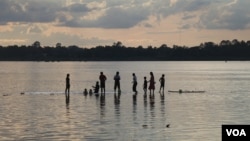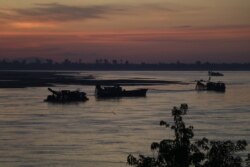Government data released on July 17 showed water levels in the Mekong River are lower than at this time last year, on account of poor rainfall along the mainstream in Cambodia, with others pointing to hydropower dams in China and Laos.
The Ministry of Water Resources and Meteorology issued statistics on Friday that showed the Mekong River levels lower than they were last year, except at Neak Loeung in Prey Veng province. The statistics show that the level on July 17 was lower than on July 16, and is expected to continue to get lower till July 20.
The water level in Kratie on July 17 was 9.21 meters, according to the Ministry of Water Resources data. However, last July, the Mekong River Commission (MRC) reported that the level in Kratie was 9.31 meters, showing that the level is already lower than last year.
Also, the MRC reported in that same report that the lowest ever recorded level at Kratie was 9.15 meters. According to the ministry’s projection, the Mekong River, which will reach 9.05 meters on July 20, will likely see its lowest ever recorded water level in Kratie.
Chan Yutha, secretary of state at the Ministry of Water Resources, said there was no rain in the Mekong area, which is why the water levels were low, adding that there were predictions that rain would increase in August.
“The Mekong’s water has a close link with the weather,” he said. “There is not much rain in the Mekong River area.”
Cambodia is one of the most vulnerable countries to the effects of climate change, according to multiple global reports. However, experts point to heavy hydropower dam construction along the Mekong as one of the causes of low water levels in the river, as well as limited efforts made by the government to mitigate the effects of drought conditions.
Kol Vathana, deputy secretary-general of the Cambodia National Mekong Committee, said the main reason for decreasing Mekong water levels was climate change, but added that the construction of dams along the upstream had only a “minor factor.”
“I don’t dare to make the hypothesis that the dams don’t have any impact on the decreasing water levels. It has a tiny contribution,” he said.
“The dams in Laos are run of the river [systems]. They don’t keep water in large storage,” he added.
In a run of the river system, running water is diverted from a flowing river to drive the generators, after which the water is fed back into the main river further downstream.
The U.S.-based Stimson Center, which tracks development along the river, published in April new data showing that while the lower Mekong Basin was facing a severe drought, the upper basin had high rainfall and snowmelt, with China’s dams restricting nearly all of this record flow.
Soeung Romchar, a 31-year-old villager in Kratie province’s Sambo district and where a potential dam is under consideration, said there was little rain in the last month and that the monsoons had not set in the area. She was worried about the prospects of her two-hectare rice field.
“There has been no rain for a month already,” she said. “[The water level] is lower when they start storing water for the dam.”








